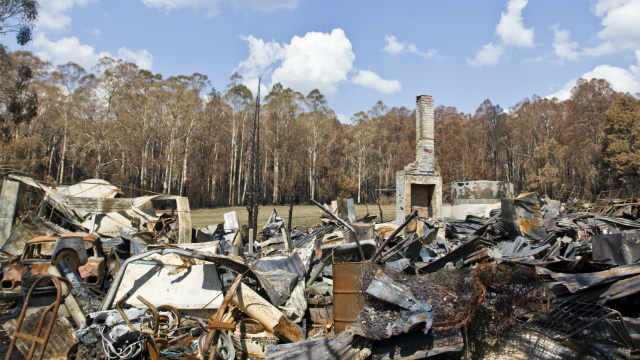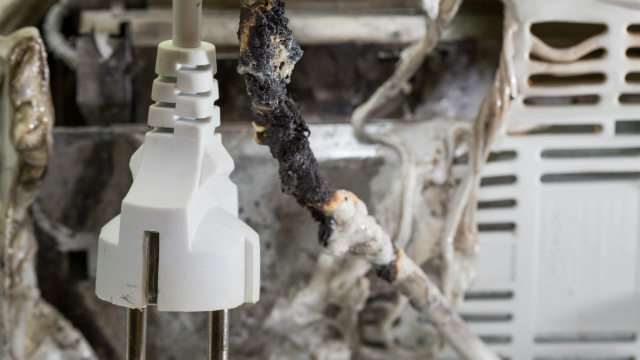Does your home and contents insurance cover fire damage?

The 2019-2020 Australian bushfire season claimed the lives of 33 people, destroyed thousands of homes and burnt millions of hectares of land.
Despite wetter conditions anticipated this year due to the La Niña weather system, the Bushfire and Natural Hazards Cooperative Research Centre (CRC) has warned that parts of Queensland and Western Australia will still face above normal fire potential this season. The wetter weather could also lead to increased grass growth, which in turn could heighten the risk of fast-running fires in grasslands and cropping areas over summer, according to the Bushfire CRC and the NSW Rural Fire Service.
La Niña continues in the tropical Pacific, with international climate models suggesting it's likely to continue at least through February 2021.
Learn more in our latest Climate Driver Update: https://t.co/DhK6h1TU1G #LaNina #ENSO pic.twitter.com/DnQr7LM64q
— Bureau of Meteorology, Australia (@BOM_au) November 10, 2020
Now that the bushfire season has begun, it may be a good idea for homeowners to take the time to prepare their home against bushfires, as well as to check if they have adequate insurance to cover them financially in the event their home or contents are damaged or destroyed by a fire. In this article we will explore the following topics:
- Does your insurance include fire protection?
- What insurance is available for fire damage?
- What is not covered by fire insurance?
- Is there a waiting period?
- What types of fire insurance cover is available?
- Can I get fire insurance cover if I live in a bushfire-prone area?
- What to do when making a claim
- How do you make sure you have adequate fire cover?
- Reducing the risks of fire damage
Does your insurance include fire protection?
At the time of writing, all home and contents insurance policies on Canstar’s database include, as standard, a level of financial cover for loss or damage caused by fire, including bushfires and house fires. Canstar Research also found that 60% of policies on our database also cover damage caused by heat, ash, soot or smoke, when your home or contents have not caught on fire.
While you may find your insurance does provide a level of cover for fire, it could still be worth checking your policy’s Product Disclosure Statement (PDS) or contacting your insurer directly to determine what types of fires are included and if any exclusions or waiting periods apply.
Shopping around for a home insurance policy?
Whether you're looking for home, contents or combined cover, you can easily compare from 100+ policies with Canstar.What insurance is available for fire damage?
Home insurance
If you want to insure your home building, outbuilding or any permanent fixtures from damage or loss caused by a fire, then you may want to consider home insurance. This type of insurance is typically only available to those who own their own home. For those wanting to protect their contents while renting, it may be worth considering renters insurance.
Depending on the policy and level of cover chosen, home insurance may include cover for:
- Repairing or replacing your home or permanent fixtures
- Demolition and removal of debris
- Temporary accommodation while your home is unliveable
- Professional fees, such as for architects or surveyors
Read your policy’s PDS or get in touch with your insurance provider for more information about what is included in the cover and any exclusions that apply.

Contents insurance
If you want to insure your personal possessions such as furniture, appliances and electronics from damage or loss from a fire, then you may want to consider contents insurance.
Depending on the policy and level of cover chosen, this type of insurance may include cover for:
- The repair or replacement of your belongings
- Removal of your damaged items
- Spoilage of perishable food or medicine up to certain benefit limits
- Damage to or loss of guests’ personal possessions while they are visiting your property when the fire event occurred, up to certain benefit limits
- Payment for moving or storage fees for your undamaged contents if a fire makes your home unliveable
Read your policy’s PDS or contact your insurer for more information about what is included in the cover and any exclusions that apply.
Home and contents insurance
For people looking to cover both home and contents from fire damage or loss, most insurers offer a combined insurance policy. Check the policy’s PDS for a list of inclusions and exclusions associated with a combined policy.
Compare Home and Contents Insurance
What is not covered?
There are a range of exclusions that may apply to your home and contents insurance when it comes to fire cover. Depending on your policy, these may include loss or damage arising from:
- Heat, ash, soot and smoke when your home or contents have not caught on fire, unless it is caused by a burning building within a certain distance of your home
- Electrical arcing, scorching, or melting where there were no flames, unless a fire spreads from the initial burn spot
- Deliberate, malicious or criminal acts carried out by the policy holder and/or family members, or by guests to the house
There may also be exclusions surrounding items which are designed to be exposed to heat, such as cooking appliances or home heaters. If these items are damaged or destroyed during normal use, then cover may not be available to replace or repair them. However, if a fire starts from these items and that fire damages other items in your home or the home itself, then your insurance may provide a level of cover.

Is there a waiting period?
Most home and contents insurers include a waiting period, usually around 72 hours, from when you first take out the insurance to when you can make a claim, potentially leaving you unprotected if you were impacted by fire in this window. Check with your provider to see if a waiting period applies.
What types of cover are available?
There are two types of home and contents insurance you can choose from – total replacement cover and sum-insured cover.
1. Sum-insured cover
Most insurers will operate on a sum-insured model. These policies will cover damage or replacement to your home or contents from fire up to a fixed value, set by you and your insurer.
In the event of a total loss from a bushfire, you may be left underinsured if the agreed amount does not adequately cover the cost of rebuilding or replacing your home and contents. It may be worth checking your insured amount to see if it is relevant to today’s prices.
Some insurers may also offer extended replacement cover, which will add a certain percentage of payment above the sum-insured amount. This may range from 10% to 30%. Extended replacement cover may be offered as an inclusion under your sum-insured policy, or as an optional extra for an increased premium.
2. Total replacement cover
These policies will typically cover the estimated costs to repair, rebuild or restore your home or contents to the state they were in before the damage or loss occurred from fire. To determine the sum owed to rebuild or repair, your insurer will typically need to do a full assessment of the damage or loss that has occurred. This type of cover generally carries a higher premium than a sum-insured policy.
Can I get cover if I live in a bushfire-prone area?
If you are living in a bushfire-prone area, such as near coastal scrub, rural grasslands and paddocks or in dense bushland, you could still get fire cover under home and contents insurance; however, there may be some additional considerations when assessing your insurance options.
Change to building codes
In 2010, following the deadly Black Saturday bushfires the year before, the national Building Code of Australia was amended, and several states followed suit by giving effect to these amendments in legislation. Properties in at-risk areas now have Bushfire Attack Level (BAL) ratings and must be built using specific designs and materials, such as gutter guards and window shutters. These new requirements can significantly increase the cost to rebuild your home if it is lost in a fire.
So, if you live in a bushfire-prone area, you may need to insure your home for more than its current price to account for the cost of implementing these building requirements. To do this you could consider a total replacement policy, or if available, add extended replacement cover to your sum-insured policy.
#Bushfire Attack Level #BAL measuring building potential exposure: ember attack, radiant heat & direct flame contact pic.twitter.com/6IWyAw1grV
— Lew Short (@lewshort14) September 11, 2015
Increased premiums
Most insurers will factor in where your home is located when calculating your premium. Because living in a bushfire-prone area increases your risk of damage or loss from a fire, this will likely increase the premium you are charged. If you are not sure if your home is in a bushfire-prone area, check with your rural or regional fire service, or your local council or state government for details.
What to do when making a claim
If your home or contents are damaged or destroyed by a bushfire, contact your insurance company in the first instance to seek advice about the claims process and avoid doing any repairs unless you have written permission from your insurer.
It is also a good idea to take photos of any damaged contents or property to use as evidence for your claim before you remove or throw them out. Also try to provide your insurer with as much information as you can regarding what has been lost or damaged from the fire, and answer any questions they may have truthfully.
How to make sure you have adequate fire cover
Having sufficient insurance could make a huge financial difference in the recovery process if your home and contents are damaged or destroyed by fire. To help ensure you have adequate fire cover, it may be worth considering the following:
- If you have a sum-insured policy, check if the amount covered matches the value of your assets. To help in valuing your home and contents, consider using an online calculator, or contacting a professional valuer for your property or items. You can also complete an inventory of your contents by doing a room-by-room evaluation.
- Carefully read your policy’s PDS to see what is covered and what exclusions apply. You can also speak to your insurer if there is any part of the policy you don’t understand.
- If you think you may be living in a bushfire-prone area, check to see what building requirements are needed for your home in the event you need to rebuild, and consider factoring in these costs to your policy.
- Shop around to try and find a policy that best suits your circumstances.
Compare Home and Contents Insurance
Reducing the risk of fire damage
You may be able to reduce the risk or impact of fire damage to your home by considering the following:
- Prepare your home against bushfires, including cleaning out your gutters, sealing around doors and windows, maintaining your garden, storing fuel and other combustibles away from the home, or adding a sprinkler system to your gutters.
- Install and maintain smoke alarms so when there is a fire at your home you can notify authorities immediately and evacuate the premises.
- Follow state or territory building standards/requirements when renovating or building your home in bushfire-prone areas.
To help protect you and those who live in your home, it may also be worth creating a bushfire survival plan. It is also important to follow the advice of your local authorities before deciding whether to stay and defend your property or to evacuate.
This article was reviewed by our Sub-Editor Tom Letts and Senior Finance Journalist Shay Waraker before it was published as part of our fact-checking process.
Cover image source: Daniel Taylor Producer (Shutterstock)
Follow Canstar on Facebook and Twitter for regular financial updates.
Thanks for visiting Canstar, Australia’s biggest financial comparison site*
→ Looking to find a better deal? Compare car insurance, car loans, health insurance, credit cards, life insurance and home loans with Canstar. You can also check your credit score for free.

- Does your insurance include fire protection?
- What insurance is available for fire damage?
- What is not covered?
- Is there a waiting period?
- What types of cover are available?
- Can I get cover if I live in a bushfire-prone area?
- What to do when making a claim
- How to make sure you have adequate fire cover
- Reducing the risk of fire damage
 24/7 claims
24/7 claims
 Online discount
Online discount
 New for old
New for old
Try our Home Insurance comparison tool to instantly compare Canstar expert rated options.


